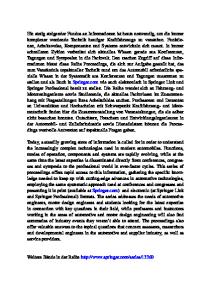Advanced Composites for LIDAR Applications
- PDF / 1,110,610 Bytes
- 11 Pages / 612 x 792 pts (letter) Page_size
- 75 Downloads / 405 Views
FF3.5.1
Advanced Composites for LIDAR Applications Witold Kowbel, Jim Withers and Rigel Woida MER Corporation, Tucson, AZ 85706 [email protected]
ABSTRACT The current generation of laser diodes suffers from poor thermal management. Typically, Cu-W is used as a submount material. Although it offers a good CTE match with GaAs, thermal conductivity is very limited (160 W/mK). A new approach to improving the thermal management of laser diodes was developed involving the use of hybrid CC/graphite foam composites. We also have a novel technology developed for LIDAR optical structures consisting of SiC-SiC composite material which exhibits excellent fracture toughness and homogeneous CTE.
INTRODUCTION High power laser diodes enable high power lasers as well as serve as pump diodes for telecommunication. The diode source is typically hermetically packaged on a submount requiring both thermal and electrical conductivity. It is critical for the submount material that the coefficient of thermal expansion (CTE) match that of the semiconductor material for the preferred hard solder die attach. Soft solder solutions allow a greater CTE mismatch, but are less reliable due to creep, voids, etc. CuW (approx. 10/90%) which matches the CTE of GaAs is currently used. The die attach must be well aligned with the edge to limit light obscuration with underhang and poor heat sinking with overhang. This imposes stringent requirements on the edge quality. The performance reliability of laser diodes can degrade severely if there is difficulty in removing the waste heat. Higher operating temperatures also reduce the lifetime of the laser diodes. The laser diode wavelengths also increase with temperature. To have high overall optical conversion efficiency in a telecommunications pumping application the temperature is required to be uniform throughout the arrays. The isothermality and temperature control allow maintenance of precise laser wavelength, higher output efficiency and lower thermally induced stresses. SiC optics have been considered for LIDAR applications for a long time. The fundamental limitation of monolithic SiC is its, very low fracture toughness which greatly limits its reliability.
EXPERIMENTAL THEORY High thermal conductivity C-C composites were produced using a one step process described elsewhere [1]. P-30X 4k carbon fibers were coated with uncured resin, this is used to form a pre-
FF3.5.2
pegg. Fiber-tow process was used to make pre-preggs which were subsequently molded onto 0/90 configuration. A single heat treatment up to 3000 °C was used. A graphite foam was produced from the AR pitch, generic name of Mitsubishi product. Foaming pressure and the final heat treatment temperature were identified as the key processing parameters. Scanning Electron Microscopy (SEM) metrology was used to analyze the composite cross section and coating uniformity. Thermal diffusivity was measured using a laser flash method while the heat capacity was measured by Differential Scanning Calorimetry (DSC). Thermal conductivity was calcula
Data Loading...











